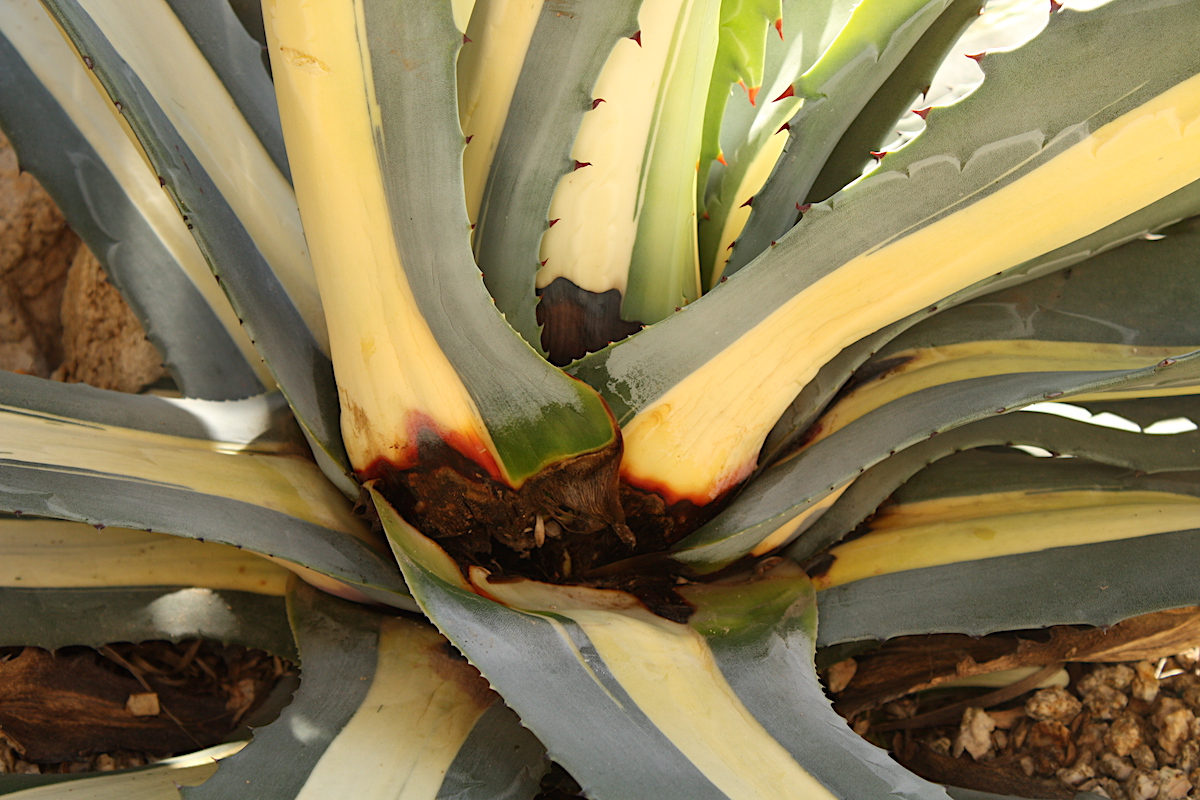
Agave Snout Weevil Prevention and Treatment
I've researched the agave snout-nose weevil since 2016, updating this page as new info becomes available. I welcome your insights, comments and questions. -- Debra Lee Baldwin
If treated early enough, infested plants may survive. See the video above or scroll down to HOW TO TREAT YOUR AGAVES below.
What Insecticide should you use?
JAN. 2025: NEW CA BILL PROHIBITS THE MOST EFFECTIVE SNOUT WEEVIL PREVENTATIVE: IMIDACLOPRID
The bill reads: "A person shall not sell, possess, or use a pesticide containing one or more neonicotinoid pesticides [which includes imidacloprid] for any use that is excluded from the definition of “agricultural use” in Section 11408 on nonproduction outdoor ornamental plants, trees, or turf, with the exception of use and possession by state certified applicators and sale by state licensed pest control dealers."
Does this mean your agaves are doomed?
It could, if you do nothing. Snout weevil WILL find them; it's just a matter of time. To prevent the pest from destroying your agaves, apply alternatives to the neonicotinoid imidacloprid every two months (see below). Or have a pest control expert who's licensed in CA apply imidacloprid for you, twice annually.
Imidacloprid Alternatives (also in video above)
Pest control expert Chris Misoguchi, who is licensed to work in San Diego County, recommends a double-barreled approach: Apply acephate and bifenthrin every 60 days, per label instructions.
(1) Drench with acephate
Dissolve one teaspoon of granules per gallon of water and pour onto the agave or spray beneath its lowest leaves. Avoid doing so on a hot day; the ammoniated nitrogen can burn the leaves. (For active infestations that can't wait until cooler days, drench at dusk.)
Note: A "systemic" insecticide is taken up by roots into the system of the plant. It kills grubs that consume tissues.
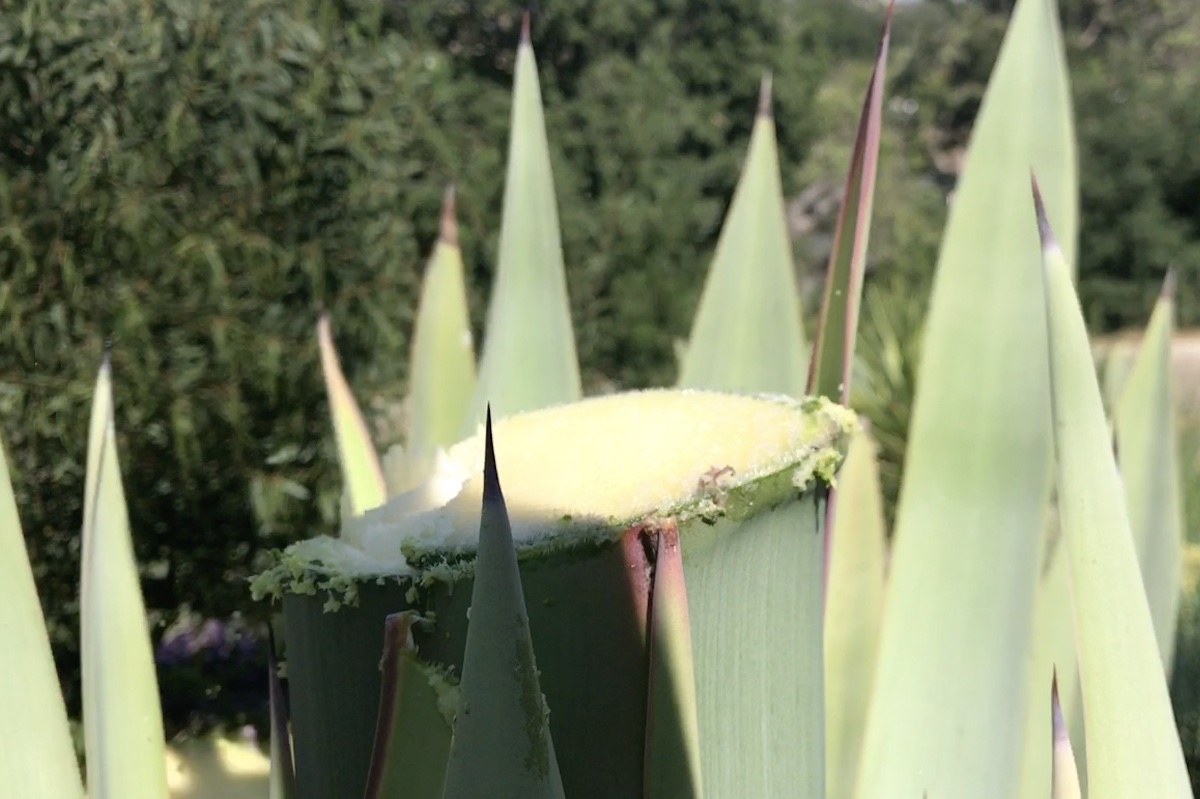
Sawed-off agave flower spike
When one of my agaves eventually flowers---which can take decades, depending on the variety---I saw off its bloom stalk in case nectar or pollen might contain traces of insecticide.
(2) Surround your agaves with a barrier of bifenthrin, a pyrethroid insecticide that kills mature weevils on contact. A tip-and-pour spout shows how much to use, or mix 2 Tablespoons per gallon of water. Apply around the base of the plant.
DO YOU LIVE OUTSIDE CA?
Drench agaves every six months, regardless of season or temperature, with:
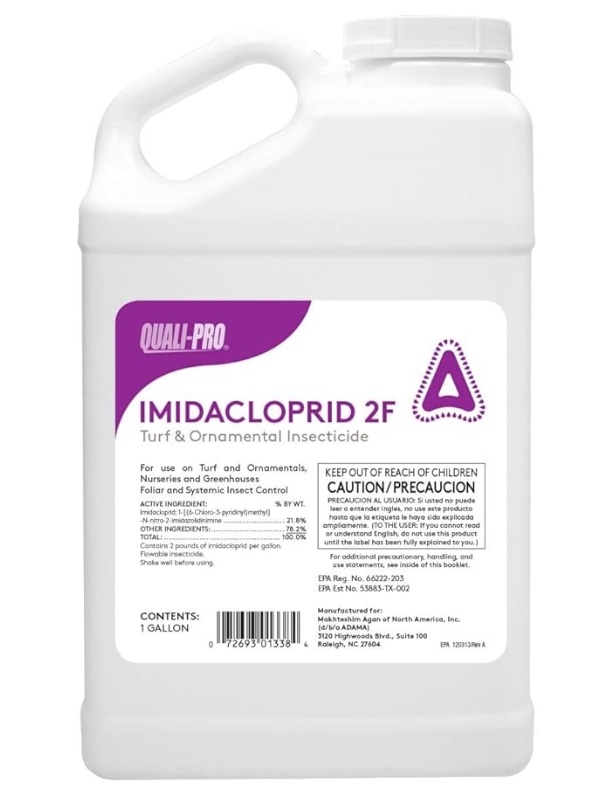
Arizona residents can use imidacloprid to deter snout weevils
Follow the label directions for shrubs, approximately 3 T per 5 gallons of water. Drench with one gallon of the mix per foot of height up to 5 gallons.
ARE YOU IN EUROPE? Scroll to the Comments and read Carina's, posted May 8, 2022.
Meet the Weevil
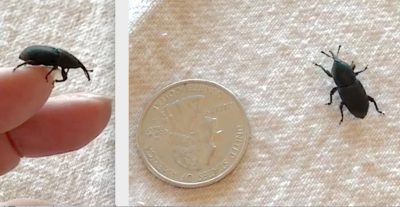
Agave snout-nose weevil
The agave snout-nosed weevil is a half-inch-long black beetle with a downward-curving proboscis that enables it to pierce an agave’s core, where it lays its eggs. Grubs hatch, consume the agave’s heart, then burrow into the soil to pupate.
The weevil (Scyphophorus acupunctatus)---once prevalent only in desert regions and Mexico---is spreading rapidly throughout the US and abroad, earning it the dubious distinction of being one of the "Top 100 Worst Global Invasive Species."
Non-Agave plants also at risk
The weevil reportedly will attack golden barrel and columnar cacti (such as Mexican fence post Stenocereus marginatus) and Agave relatives such as Beaucarnea, Yucca, Mangave and Furcraea.
Learn more on my "snout weevil plants" page.
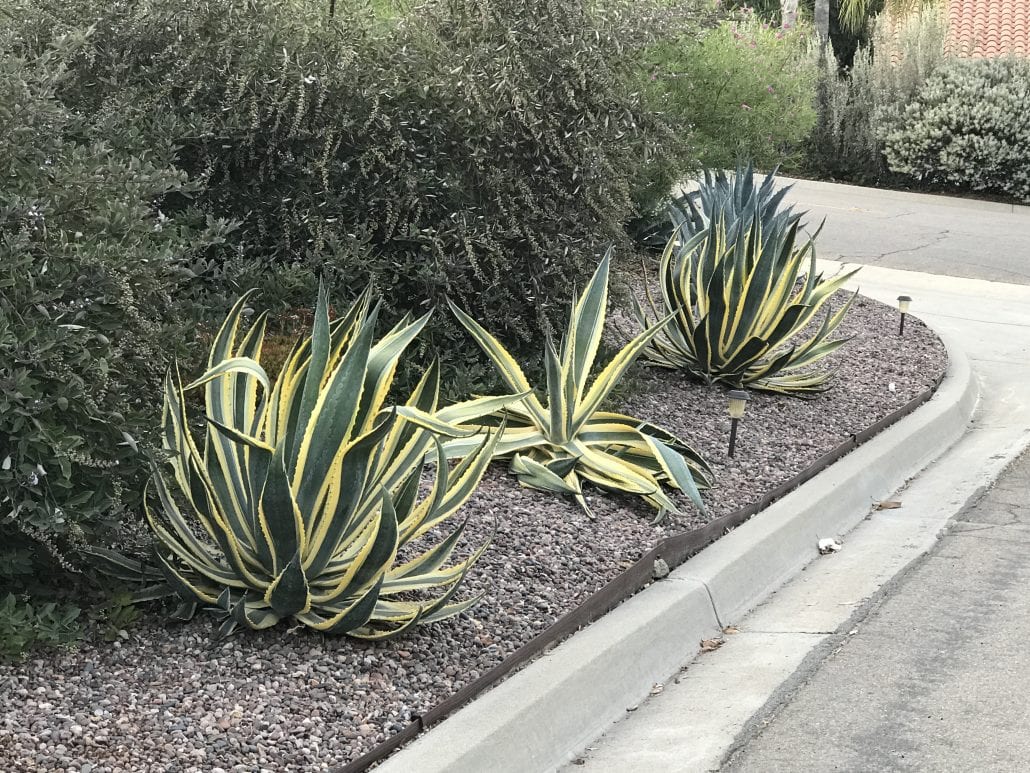
An upright center cone and drooping outer leaves are a sign of snout weevil. Such plants, lacking roots, will rock or fall over when pushed.
How to treat your agaves
When applying a systemic, the goal is to get it to the agave's roots.
- Follow label directions. Wear gloves and protect your skin and eyes.
- To mix the solution, I use a hose, a 3-to-5 gallon bucket, and a stick for stirring.
- If the label doesn't say how much concentrate per gallon of water for agaves, go with the ratio it gives for shrubs.
- Slosh the solution where lowest leaves meet the core. The goal is to effectively drench the soil at the base of the plant.
- Apply at first sign of infestation and repeat in 3-4 weeks.
- As a preventative, treat bi-monthly.

Does temperature matter?
Yes, especially if drenching with acephate. Apply at dusk if daytime temps are above 80 degrees---otherwise, you risk burning the plant's tissues.
How about if you're using imidacloprid? Evidently it doesn't matter. Arizona resident Jeff Kerner emailed: "...even though the weather was very hot, I took a chance and used an imidacloprid drench on several of my large agaves, and they all made it through the intense heat here in the Phoenix area without any further signs of attack or stress."
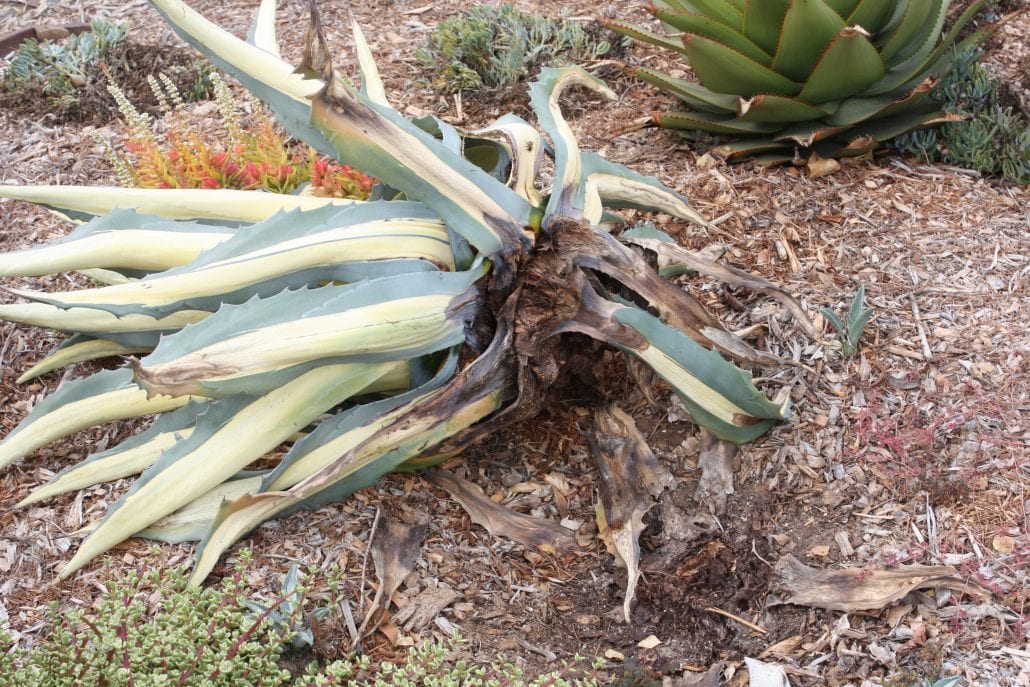
Is your agave infested?
Look for damaged tissue where leaves meet stem. The lowest leaves will appear wilted, and may slope unnaturally downward while the center cone remains upright. The plant, no longer anchored by roots, will rock when pushed.
When an infestation is well underway, it's possible to shove the agave over onto its side. It'll break at soil level, revealing a mushy, foul-smelling core infested by plump, squirming, half-inch, cream-colored grubs with brown heads.
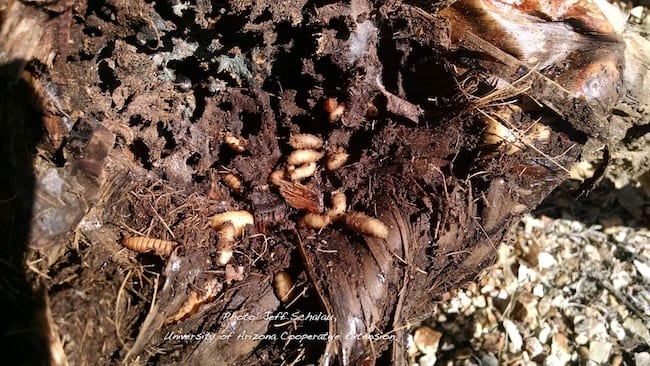
Above: an agave's grub-eaten core resembles a sponge. Watch my Instagram video of a grub-infested agave.
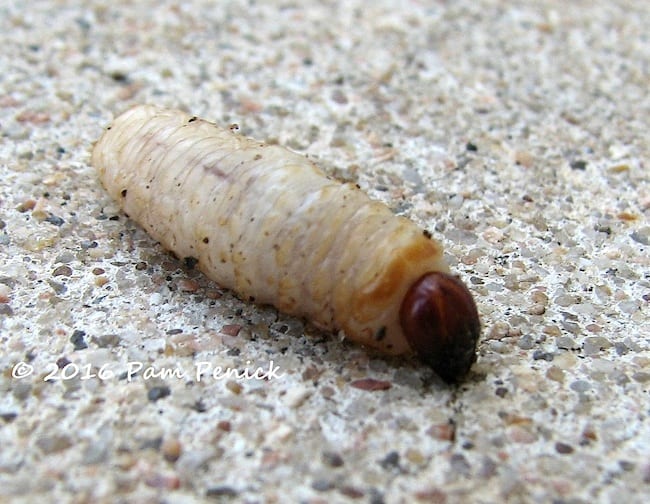
Above: Close-up of a snout-nose grub.
Encouraging news ~
-- Agaves treated early in an infestation may recover, providing there's adequate meristem tissue to regenerate new growth. An agave's meristem cells are at the core, or heart, where leaves join roots. It's prime grub fodder.
-- An organic control currently being tested is a pheromone trap designed to attract adult beetles in search of mates.
-- Weevil-resistant agaves are under research. Tissue-culture labs make it possible to produce quantities of plants over a short period of time. This is likely the future of commercially-sold members of the Agaveaceae family.
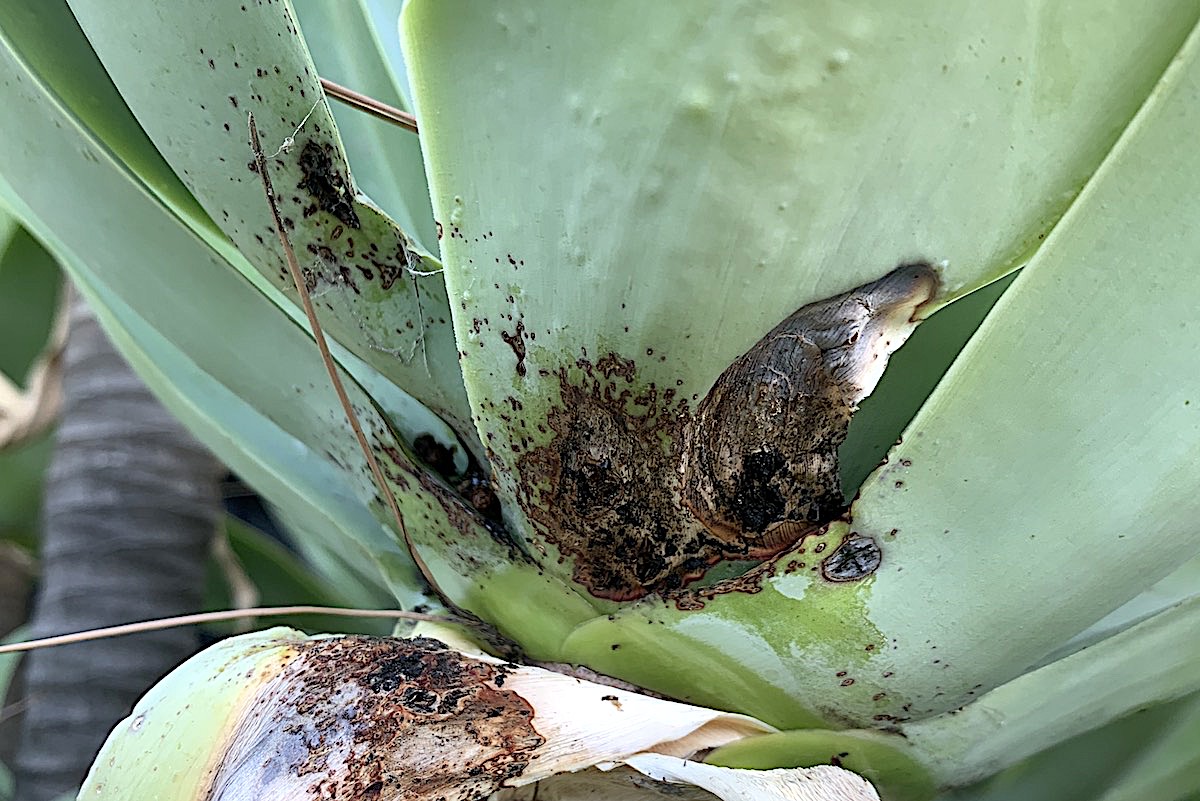
-- The weevil seems less inclined toward agaves with thin, flexible leaves, such as Agave attenuata; those with tough, hard-to-pierce leaves (such as agaves desmetiana, murpheyi, parryi, lophantha 'Quadricolor', 'Sharkskin', triangularis, victoriae-reginae and vilmoriniana); and those with slender, nonjuicy leaves such as agaves bracteosa, filifera and geminiflora. See photos on my website's Agaves page.
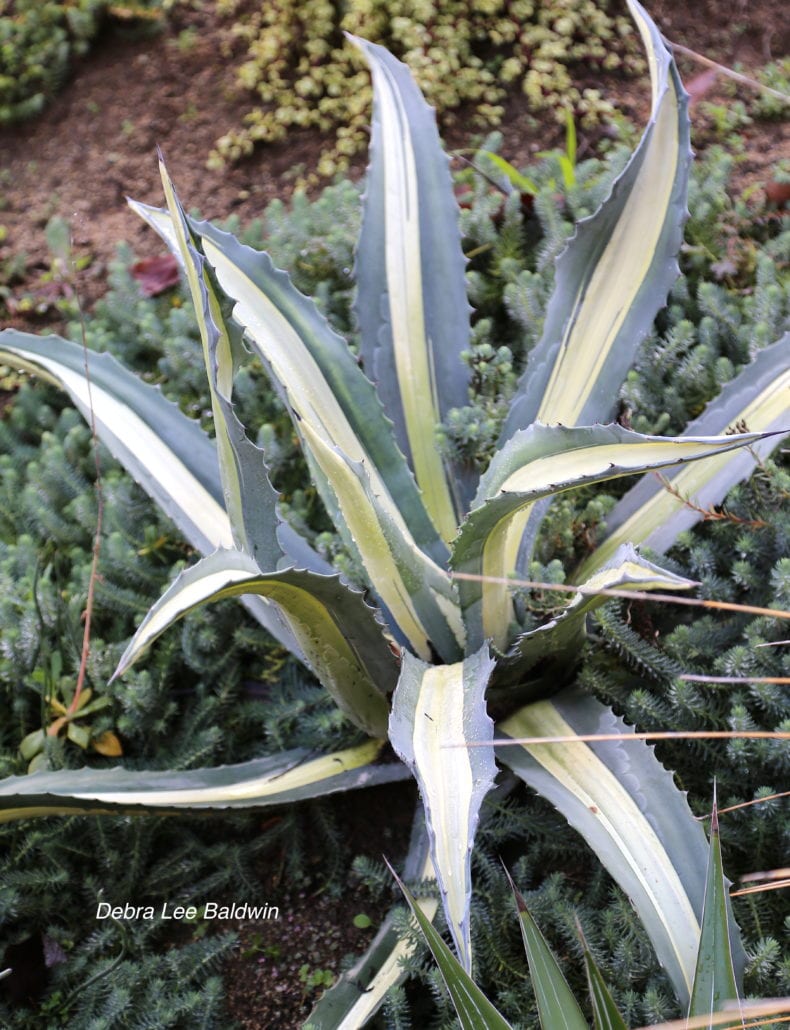
Above: An agave a year after being treated for active snout-weevil infestation. The weevil had consumed part of the core, but enough remained intact that the plant was able to grow new roots.
Maybe it's just a gopher. When you see an agave on its side, and its base has been chewed into a concave bowl, with no sign of rot or grubs, AND there's a mound of soil nearby or filling the core from below, yes the plant is a goner, but the culprit is probably a gopher. This photo is on my Succulent Pests & Problems page:
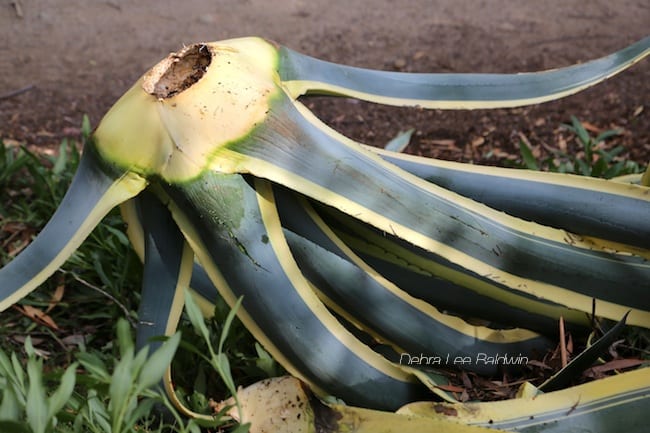
After eating the agave's roots, a gopher continued upward into its core.
How to remove a diseased agave
1. Place a tarp around the plant.
2. Position a wheelbarrow nearby. Make sure the tarp covers the ground between it and the agave.
3. Dig up the agave and put in the wheelbarrow.
4. Dig out more dirt to a depth of 12 inches (deeper if you find grubs) and about 12 inches from where the base of the plant was.
5. As you transfer the soil to the wheelbarrow, inspect it for grubs and weevils.
6. The beetles are hard to crush. Use a hammer.
7. Take the wheelbarrow to a paved area like your driveway, so if beetles escape they're easy to spot.
8. Transfer into heavy-duty trash bags, sprinkle contents with insecticide, and triple-tie.
9. Seal any rips with duct tape.
10. Drench the soil where the agave was with insecticide.
Aren't insecticides bad for the environment?
Although I don't advocate inorganic pesticides, and I certainly am not a licensed pest control expert, I believe that the responsible thing to do is to share knowledge based on research and personal experience, and to do what I can to prevent the beetle from spreading.
Hire a licensed pest control expert
You'll know for certain that everything is done safely and protects the environment while eradicating the pest from your property. Jeanne Meadow, whose garden I show in the second edition of Designing with Succulents and on my YouTube channel, recommended Chris Mizoguchi to me. See him in the video at top of page.
GREEN ALERT: Insecticides may kill beneficial insects as well as pests and may disrupt your garden's natural predator-prey balance. Snout weevils have coexisted with agaves for millennia and are naturally preyed upon by reptiles, birds and mammals (though the spines that protect an agave from predation also protect the weevil).
Systemics, as the name implies, transmit insecticides through a plant's system. Some studies have indicated that bees and birds are not harmed by the nectar of treated plants, and that animals farther up the food chain are not at risk. Even so, when a treated agave begins to form a bloom spike, cut it off before buds open. (See how in my video, at 6:07.)
Use insecticides sparingly and follow label directions. Don't pour the solution (or for that matter, anything inorganic) into drains or gutters.

WEEVIL CONTROL WITHOUT PESTICIDES
What to do: Remove an agave at first sign of infestation and sift grubs and weevils out of the soil. (Feed them to your chickens or put them out with the trash in sealed plastic bags.)
Don’t plant agaves in that part of your garden again, and watch your other agaves for signs of infestation.
It's possible that beneficial nematodes may be effective. They do kill larvae, but I've yet to find out if they'll work against snout weevil grubs. (Check back.)
Earthworm castings may destroy beetle exoskeletons, advises Pat Welsh, author of Pat Welsh's Southern California Organic Gardening: Month by Month. In Jan, 2018, in response to this post, she wrote: "Purchase earthworm castings and spread them on top of soil surrounding agaves. Keep it up. Earthworm castings kill all insect pests and are a great barrier to the ones that live in the ground under plants. Weevils walk on top of soil and cannot cross earthworm castings or they die. This is because earthworm castings contain chitinase, an enzyme that destroys chitin. The exoskeletons of insects are made of chitin."
Economic impact
According to the Global Invasive Species Database, "Scyphophorus acupunctatus is becoming a major pest of native Agavaceae and Dracaenaceae species worldwide. From Mexico, it has decimated populations of Agave crops there, in particular those used in the tequila industry. The importation of ornamental Agave plants worldwide has facilitated S. acupunctatus to establish in many parts of the world, particularly in Central America and the Caribbean, in Africa, Asia and South America."
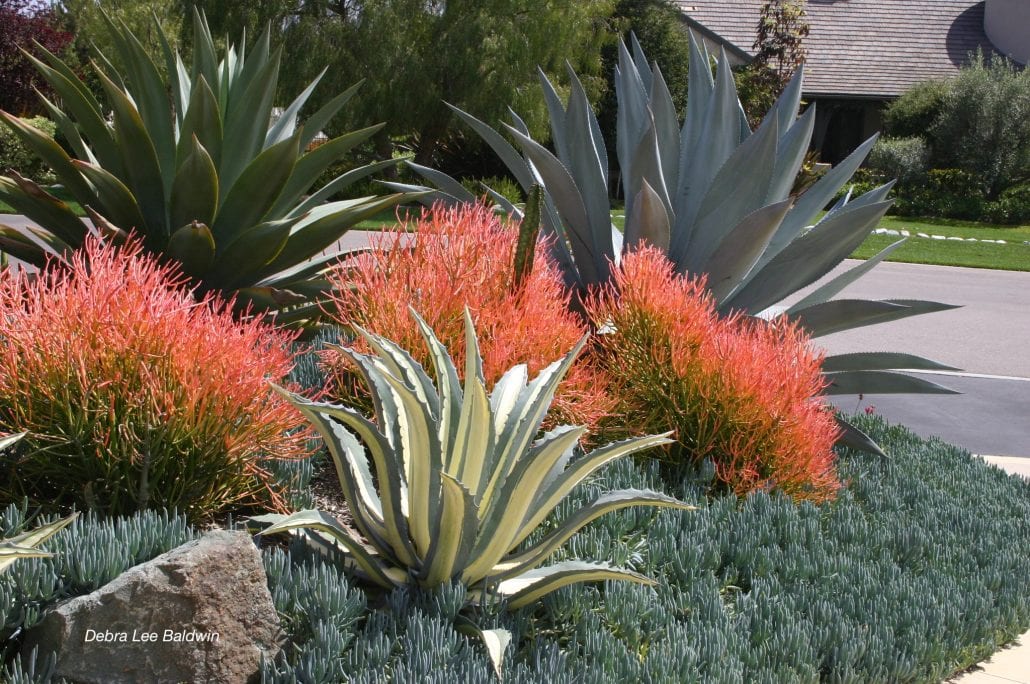 The big green agave at left is likely a hybrid of A. salmiana; at right is A. franzosinii. In the foreground is "snout-weevil candy": A. americana 'Mediopicta Alba'.
The big green agave at left is likely a hybrid of A. salmiana; at right is A. franzosinii. In the foreground is "snout-weevil candy": A. americana 'Mediopicta Alba'.
It's possible that certain species may actually attract weevils to your yard.The pest seems to prefer specimens of Agave americana and its variegates (striped varieties), as well as closely related Agave franzosinii, one of the largest agaves.
Halt the Pest by Sharing Info
It's only a matter of time before weevils in neighbors' agaves find their way to yours (and vice-versa). The unfortunate reality is that agave owners who do nothing are inadvertently aiding the proliferation of a serious pest, and may incur the expense and inconvenience of removing prized, immense, and spiky plants.
HOW TO GET THE WORD OUT
Feel free to copy-and-paste the following paragraph onto your site, and/or email it to friends, neighbors, and members of your garden club or homeowners' association:
The agave snout-nosed weevil exists in greater numbers and is more active than ever. Don't wait for signs of infestation; take preventative measures now. And please, don't let your yard become a breeding ground for weevils that move on to your neighbors! Learn More: https://debraleebaldwin.com/caring-for-succulents/agave-snout-weevil-prevention-treatment/
More info
**Chemical & Engineering News, Dec. 16, 2018: "Fibronil blamed for historical bee deaths"
UC Nursery and Floracultural Alliance Regional Report, Spring 2016, "Agave Pests"
Global Invasive Species Database
Desert Botanical Garden, Phoenix, AZ
Pam Penick's blog post: "Evil Weevils! Agaves Under Attack in Austin"
Tropical Texana blog: http://tropicaltexana.blogspot.com/p/agave-weevil-eradication.html
NOTE: Links to Amazon are affiliate.
Don't assume nursery agaves are weevil-free!
Before planting, remove an agave from its nursery pot, set the plant (root ball and all) in a wheelbarrow, and hose the soil off the roots. Examine the plant for beetles and puncture holes, and the soil for grubs. If a plant is infested, destroy it and inform the source nursery. See how in my video:
Related info on this site
Agaves: Uses, Photos, IDs and Varieties
With the exception of a few soft-leaved and variegated varieties, agaves want sun—the more the better in all but desert climates. Most are hardy to the mid- to high-20s F, and some go a lot lower. Sharp points at leaf tips and along leaf edges can make agaves treacherous. I snip about a quarter inch from leaves’ needlelike tips with garden shears.
Succulents Snout Weevil Attacks Besides Agaves
Check agave relatives for snout-nose weevil. Don’t wait for signs of infestation; take preventative measures now to protect your agaves, furcraeas, beaucarneas, mangaves and yuccas. See photos.

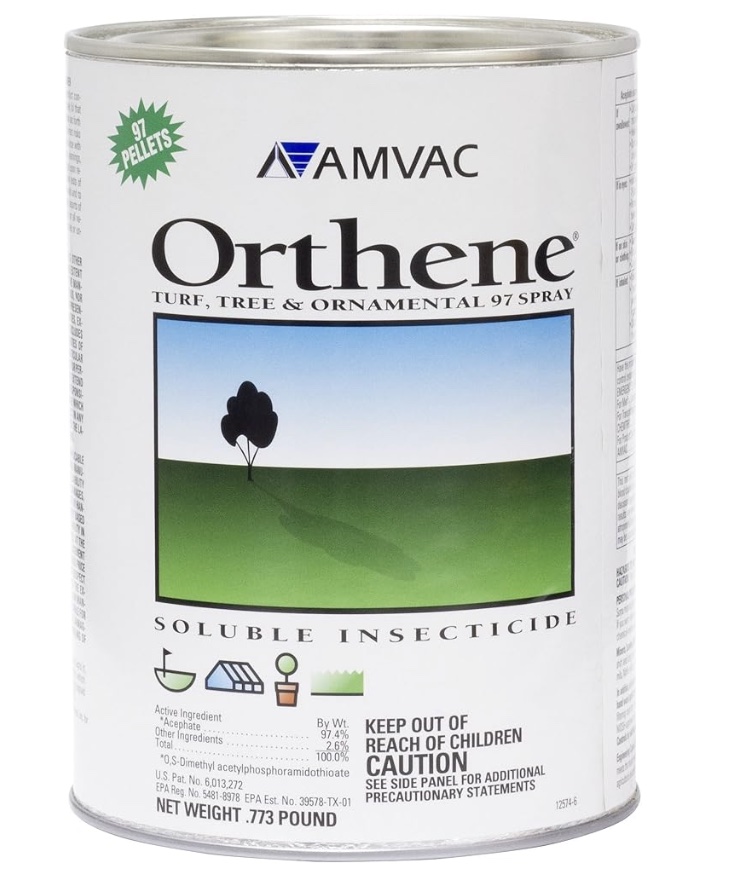
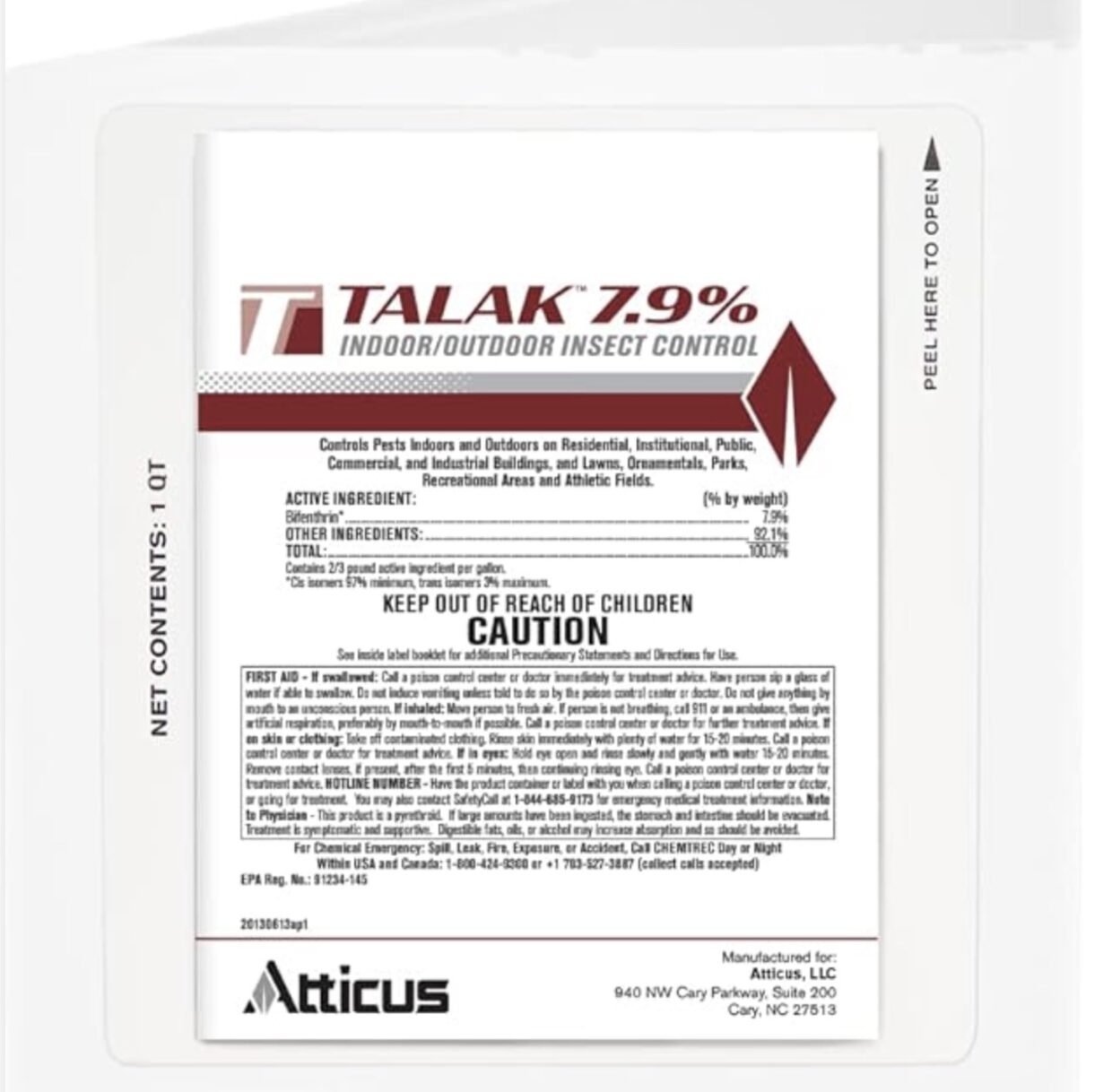
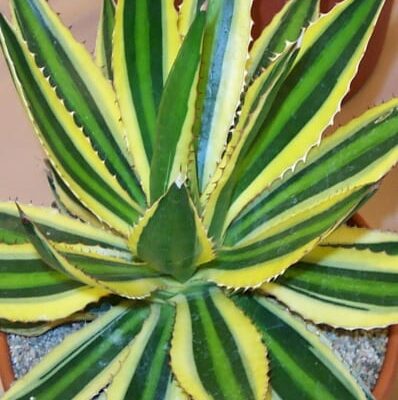
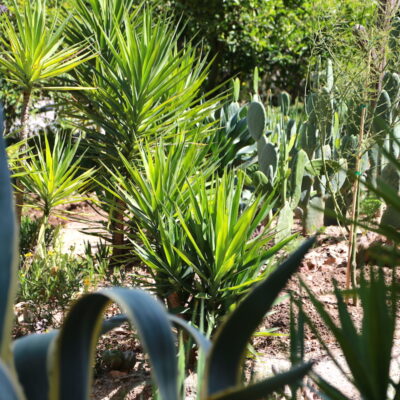
Hi Debra, Thanks for the article. I found one of my agave mediopicta alba plants was infested when it topped over as I pushed on it. The roots were completely gone and it had weevils boring into the bottom. Oddly, the top of the plant didn’t show many signs except the leaves were beginning to cup inward and it looked somewhat anemic. The nursery I purchased it from said this was common (I suspect they sell lots of infested plants) and told me to remove it and soak the plant bottom in a solution of water and liquid insecticide to kill the bug and then replant it. They referred me to Grangettos who they said would give me the products needed. I’m at work so I don’t have the exact product name but it was a Bayer product and basically a broad spectrum insecticide that kills everything. I soaked the plant as directed and put it in a pot treated with a granular formulation of the same product and left it there until it looked happy and started growing again. I lose track of time but this was probably 3 – 4 months. Then I removed it to find nice new roots and put it back in the ground where it was originally planted. I also treated the other plants with the granular product. Nursing it back to health in a pot may have been overkill.
Hi Jeff — I’m surprised they told you to treat and replant it. Its meristem tissue must have been somewhat intact. The thing is, the weevil injects a microbe into the agave that softens its tissues, so that the grubs can eat it. I’ve never heard of an agave surviving that. I’m very glad yours did, but I’d hesitate to recommend others try it. Usually the plant is too far gone.
UPDATE, Jan. 2018: I’ve since heard of agaves regenerating after infestation. Very good news! But of course if the core is too far gone, it’s best to destroy the plant and get rid of any beetles and grubs.
Agave snout weevils here in Southern Spain fly.They walk, but they also fly.
I called the manufacturer to find out the how much Imacloprid concentrate to dilute with how much water, because the information is not not on the label, and all their “expert” would do is read me the label. However, I did find this helpful info on the San Diego Master Gardener’s website: “Gardeners can buy Bayer Advanced Garden Tree and Shrub insect control (with 1.47 percent imidacloprid). You can use as little as one tablespoon of the insecticide in two gallons of water. Apply it in late February or early March. This seems to provide good control of the weevil in my East San Diego County landscape. — Peggy Katz
Thanks for the informative article. I’m in Spain and have a lot of Agave some 10ft or more tall. Every year I get casualties due to the weevil. I have found another four this week. Not the biggies though. I have always sprayed with Imidacloprid I have a 100 litre motor sprayer and add 75ml to that. It is a very small dilution rate. I am just starting to spray them all again. I cover the total plant and the shape of the leaves guide the spray right onto the base of the plant, quite a good design really. They get a really good drenching.
It does not stop everything but I hope it kills some of the little so and so’s.
Hi Mike — Agaves are remarkably well designed at channeling water (in this case pesticide) to their core and roots. Shouldn’t you treat the little ones too? They’re feeding the weevil.
Hi Debra,
I have my pesticide license and use systemic organic product that I would like to test on the snout weevil. If you are interested and if you find infected plants, email me and we can set up an experiment.
Hi everyone — Tina is in Orange County. Wouldn’t it be fantastic if there were an organic systemic that was effective? Thanks, Tina, for the info. Please keep us posted!
Hi, I need an infected plant to test. So far, there are no ASW’s on my Yuccas or Agaves.
Work in Orange County doing landscaping. I have had success in minimizing agave snout weevils using beneficial nematode applications in spring and fall. This is paired with applications of worm casting around the base of the plant, as the castings help the plants produce more chitinase & break down the adult exoskeleton. Overwatering has also played a factor in the weevil infestation. Clients, where agaves are overwatered, seem to get larger infestations than those that underwater their agaves.
Hi Kat — This is promising news, and what you say about overwatering makes sense. Thanks for an insightful, helpful comment that is “green.”
Imadacloprid is killing bees. It is one of the worst ever pesticides and will end up killing us also. Instead of that, purchase earthworm castings and spread them on top of soil surrounding agaves. Keep it up. Earthworm castings kill all insect pests and are a great barrier to the ones that live in the ground under plants. Weevils walk on top of soil and cannot cross earthworm castings or they die. This is because earthworm castings contain chitinase, an enzyme that destroys chitin. The exoskeletons of insects are made of chitin.
I lost a couple of Agave Blue Flame recently here in San Marcos. I have two left as well as other, more susceptible agaves. I don’t like the idea of using chemicals/insecticides so I will start using earthworm casings. Thanks for the advice, Pat! And, keep up the great work Debra!!
Great presentation on the snout weevil. Great pictures and summaries. Hard work to stop that weevil! Wonder what the difference is between and weevil and a beetle? -Will have to Google.
The weevil lays its eggs in a tiny hole in the bud. This hole is often accompanied by several weevils. From that tiny hole the larvae burrow downward as they grow and metamorphose in the base of the plant. If you walk around periodically and examine the buds of your larger species you can catch the original infestation as it happens and avoid treating a heavily infested and damaged agave or yucca. I would of course treat at this initial phase any way. These things have infested Yucca aloifolia very badly here in the east for several decades. Fortunately the Yuccas fall over and the top reroots once the trunk has been eaten out by the larvae. The top of the yucca is minimally damaged because of the size of the young larvae near the starting point. This is probably why the agave bud shows damage much later than the outer or lower leaves.
I don’t top drench my agavacea. Have found that a pump sprayer on squirt instead of spray gets the poison where it is needed (base of bud and roots) and should reduce bi-kill of beneficial insects.
Sadly, today I removed a 4’ x 4’ agave from my yard. It fell over and was massively infected with snout weevils. I believe it was a blue agave, similar to the one shown in the upper right of the photo of 3 different agaves included in your article.
Since your article was written about a year ago, I am wondering if you currently believe dowsing soil with Imidaclorprid is still the best treatment. I have read other articles which suggest using triazanon (which I am unable to find in a Google search) or bifenthrin.
Also, have you now had experience using worm casings?
I am in Yucca Valley near Joshua Tree National Park. If the Snout Weevil gets a firm foothold here in the Morongo Basin, it could be devastating!
Thanks in advance for any additional thoughts you can share.
Hi Paula — I’m not yet familiar with those you mention. I’ve sent this along to Jeanne Meadow to ask her to weigh in. Thanks for asking!
Thanks so much for this info. I have a client in Los Angeles with several huge century agave that are absolutely infested. One was beyond saving but we are trying to save the others based on your advice!
Great article! I lost a big blue agave last year, since then I keep a close eye on the rest, today I found the weevil on the yuccas, already try to control the damage, but notice tons of little insects smaller than ants in the area, is it possible that the damage will extend to a mezquite tree, right next to the yuccas?
From El Paso TX
Hi Rosa — The insects you describe must be native to your area, because they don’t sound like anything I’m familiar with here in Southern CA. As for snout weevil moving on to mesquite, no worries, woody plants aren’t susceptible.
I have a blue agave & small ones that I think are infested with the snout weevil. I live in Apple Valley CA in the high desert. Any advice?
Hi Regina — Now that the weather has cooled is a perfect time to treat them. In the article above, scroll to How to preventatively treat your agaves in red type.
Thank you. Have subscribed to your YouTube channel & shared with our Sun City HIA. What is a good insecticide to use and which agave is best that the weevil won’t eat? Many thanks in advance
Hi Regina —
Agave experts, growers, and pest management specialists advise drenching the soil around healthy agaves with a systemic insecticide containing imidacloprid.
The weevil seems less inclined toward those with thin, flexible leaves, such as Agave attenuata; those with tough, hard-to-pierce leaves (such as agaves desmetiana, murpheyi, parryi, lophantha ‘Quadricolor’, ‘Sharkskin’, triangularis, victoriae-reginae and vilmoriniana); and those with slender, nonjuicy leaves such as agaves bracteosa, filifera and geminiflora. See photos on this site’s Agave’s page. https://debraleebaldwin.com/agave-photos-labeled-identified/
Thanks again. I’ve shared on our HOA Facebook group. Many thought gophers were eating their agaves so your information has been very helpful. My gardeners and I now have a plan of action👍🏽
Hi Debra –
Thanks again for your great web site on the agave snout-nosed weevil. While we do not currently have agave in our yard, there are numerous varieties throughout our community, city and region (Corte Bella, Sun City West and Phoenix, AZ) and many collapsing, no doubt because of the weevil. When we first moved here from California I attempted two Blue Flame Agave in decorative pots in our front courtyard and we lost both though I couldn’t figure out why at the time. Both showed significant core rot though I don’t recall seeing any weevils or their grubs. After watching the video on your web site I am pretty sure the weevils got them. We purchased them at Home Depot and I did not, until now, know to “Bare root” them as described in your video. Thanks to you, we are now more knowledgeable and will try again.
I have emailed our HOA with a request that they post an article on our community website and in our community periodical. The following link should get anyone to the email if they are interested.
https://drive.google.com/file/d/1ILx-d4m5Fur2WtV3XqEUej6suGmUfirJ/view?usp=sharing
Thanks, Wayne, for sharing first-hand experience and making others aware of this insidious pest. For those who might like to cut-and-paste the email you sent to your HOA, here’s an edited version:
I have been noticing the failure of numerous agave plants throughout our community.
Sadly, the infestation is rapidly growing throughout the Southwest. It is vitally important that information contained on the Internet at the link below be disseminated
via all channels available to us, or the infestation will continue with resultant loss of this magnificent plant.
I urge you to post this alert on our community website, publish it in the local paper, and forward it with a request for further distribution to any other channels you think may be effective in getting the word out.
Agave Snout Weevil Prevention and Treatment | Debra Lee Baldwin
https://debraleebaldwin.com/succulent-experts/agave-snout-weevil-prevention-treatment/
7-minute YouTube video, Agave Snout Weevil Prevention and Treatment: https://www.youtube.com/watch?v=uxY5213CP30&t=1s
Hi Debra. I purchased the insecticide recommended from Amazon & applies 2 days ago to all agaves. I’m trying to save them. The large one is very infected & saw the weevil run out when we applied the insecticide. We have 4 smaller ones. The landscaping committee in our HOA in Sun City Apple Valley CA sent an alert to all homeowners with the info I shared from your website. Will stay in touch. I feel empowered to be an Agave Guardian
Hi Regina — I hope you caught it in time, and that your HOA gets the word out. Yes, do stay in touch!
Hi Debra I just joined your Facebook Group
Welcome!
Hello, I wish I could post a photo to show what my agave looks like and so you could advise me on how to proceed. It took me a while to notice, I guess, but it looks like the leaves are being shredded down to the fibers. Does this sound familiar? Can you help? I can’t seem to find any photos on the internet that are similar to what is happening to my plant. There’s anothe agave within a few feet of the dying (?) infected (?) one and one afraid I’m going to lose that one as well. Would appreciate any help.
Hi Ellen — The consensus from the Facebook Agave Group is deer damage. It seems this is the rutting season.
Hi Debra
Some good news. Found 6 dead snout nosed weevils near my agave & the plants seem to have stabilized. I see no new deterioration. Also, new ones are beginning to grow. I put the dead weevils in a baggy & posted on our community Facebook pages I think I’ve begun ran agave folk hero
Regina! That’s wonderful! Really appreciate your sharing this good news. I sure hope it isn’t premature. But hey…dead beetles!
I lost an Agave gentryi ‘Jaws’ a couple of years ago to the snout weevil and have been treating with imidacloprid 1.47% since then. Knock on wood, no repeat of infestation in my yard, which features over 30 species of agaves. I just gave all my agaves their fall treatment of a drench of solution made of one fluid ounce of 1.47% imidacloprid (Bonide brand) per gallon of water.
I have a question: is it necessary to even treat the agave species Debra mentions as not attractive to the weevils? It seems they greatly prefer the Americana and its variants and the other large agave species.
Hi Tim — I too would like to know if I needn’t bother to treat, say, Agave bracteosa. Now that I have many mangaves, I’ve been treating them as well, plus my yuccas and beaucarneas. I figure the weevil will attack what it prefers first, then move on to others. It’s all-time favorite seems to be Agave americana ‘Mediopicta Alba’ (the white-striped “tuxedo agave”) which you almost never see in gardens and nurseries anymore. I have two, btw, and both have weevil holes, but they’re doing fine.
I gave up about five years ago trying to grow ”Mediopicta alba” because my plants inevitably developed an odd spontaneous fissure that longitudinally split the leaves along the border between the green and white stripes. I never found out the cause of this disfigurement, but this was several years before I started hearing about Scyphophorus acupunctatus in my area (Inland Empire foothills near the border between L.A. and San Bernardino Counties). The plants lasted for years with these curious lesions, and I didn’t see the proximal leaf shriveling and leaf drop characteristic of weevil infestation. So I doubt it was snout weevil that attacked my Mediopicta albas.
Hi Tim — I’ve never heard about agave leaves splitting along variegation borders. Curious…did it start at leaf axils and work its way up? Maybe a genetic weakness of that particular clone?
Debra–As I recall, yes, the splitting process started proximally , or near the center of the plant. I asked around at Rancho Soledad, and they had not seen such a problem in their mediopicta albas. This was over five years ago. So maybe you’re right about it being a genetic problem in that particular clone. Beautiful as it is, A. americana mediopicta alba never struck me as a particularly robust species.
Hi Tim, I agree. Not very robust. Probably due to the lack of chlorophyll. I wonder if that also keeps it small compared to its americana cousins. It’s highly commercial, though. Sometimes I wonder what amazing agaves will be bred and released to the marketplace in years to come. Hopefully pupless, slow to bloom, and weevil-proof!
Hi Debra,
I love all your advise on succulents and your book about succulent design! I started a garden in Algarve Portugal. The Agave Snout Wevil has also arrived in my neighborhood. Unfortunately imidacloprid is not allowed to use in Europe. Is there any other you would recommend? What do you think about Acetamiprid?
Thanks a lot and keep up your lovely work!
Sarah
Hi Sarah — Thank you! I’m not familiar with acetamiprid. And in any case, I’m by no means a bug or pesticide expert. To be honest, you’re in a better position to advise me, than the other way ’round. Since the evil beetle is now in your part of the world, ask nurseries, garden groups, and perhaps universities with horticultural programs what alternative to imidacloprid they might recommend, or what they’re doing to keep it under control.
Laura, you’re not an idiot! And you’re certainly not alone. I just found an agave two doors down from me that’s infested. My neighbor—who just moved in—had no idea. I felt so bad for her. What an unfortunate welcome to the neighborhood!
Hi Laura — Thanks for keeping us posted. I wish you had better news. Regarding the weevil infestation of your large Yucca elephantipis, I’m out of my depth, not being familiar with the species or with weevil attacking yuccas. However, it does seem that yuccas in general stand a chance, because they root from cuttings. And once the damage is cut out and the trees are treated, it seems likely they’ll recover…providing of course their roots are intact.
Hi Debra,
I have 5 beautiful furcraea that are 2 years old. I decided to purchase 2 more from a reputable nursery. My gardeners planted them. Within one week both were toppled over. I thought perhaps my water faulted or I had agave beetles. It turned out to be the BEETLES. We dug the plants up and threw them out.
Unfortunately they were close to my 5 other ones. I immediately drenched them with imidacloprid and have been doing this once a week.
I also drenched the soil around the infected plants. We saw at least 5 lives ones when we tossed the plants. It’s been three weeks and we have seen 3 dead ones and 2 almost dead ones.
The closest of the 5 left, was about 5 feet away and I an watching it closely. I’m hoping that I have killed the grubs with the insecticide.
I also brought in my exterminator and he sprayed them with something that kills the beetle that requires a license.
Thank you so much for your advice! I am an enthusiastic gardener who loves her plants. Your help was much appreciated.
Hi Caryn — That’s horrible. The nursery needs to know what happened (I hope you took photos) and refund your money or replace the plants (maybe with other, weevil-proof succulents). Of course, anything from that nursery might harbor beetles. You did the right thing, and I’m relieved and glad I could help. Thanks for sharing your experience.
I have lost barrel cactus, agave payrri, agave americana (some at least 15 years old), and a large cow horn agave, due to the weevil. In total, I have lost about 30 plants. I suspected gophers and too much water from rain in 2020, but the presence of grubs and the weevil itself told otherwise, and my research confirmed it. I had never heard of this weevil!! I think that it arrived on infected Mexican marigold plants that I purchased and added to my garden at that time. I removed one to replant, and the weevils were everywhere. I don’t like to use pesticides, but the situation is dire and I plan to follow the protocol that Debra suggests. I only have these plants in pots now, so the impact on the environment will be reduced.
Hi Diane — Thanks for sharing your snout weevil experience. I’m happy to tell you that I’m weevil-free after being vigilant about drenching mine two or three times a year. Funny story…I was annoyed with my gardener who failed to tell me he’d run out of the drench before doing a large agave on the property line. How did I know? I texted him after the plant rocked on its base. I planned to give him a good talking to the next time he came. The day before, I pushed the agave over, expecting to see weevils and a rotten core. Instead everything looked healthy except the roots were gone. Some of the residual drench must have protected the plant from the weevil…but not from a gopher that tunneled in from the neighbor’s yard! Interesting you lost barrel cacti too. I’d heard that they might be affected by weevils, but I didn’t want to believe it. As for how it got there, yeah, probably hitchhiked on nursery plants. Btw, I just heard from a distraught man in Spain who discovered the weevil on his agaves, so evidently it figured out how to fly—on an airplane.
Hello, thank you for this thread, we live in London, UK, we have a very large Century Agave which has lived inside since we bought it as we didn’t have time to acclimatise it outside for winter (and it was too big too move once we got it in the house) we noticed the odd beetle on the floor but thought nothing off it, over the months our agave looked more and more upset, leaves turning down and yellowing, we saw more of the beetles and then my husband whose desk is next to it started to be able to HEAR the grubs chomping away! We called the garden centre where we bought it and they say they’re looking into it but we don’t have any other agaves or similar so it must have been infested when we bought it home. They told us to move it outside and treat it with vine weevil killer but i’m concerned that won’t be enough, we don’t have other agaves and it’s not something any of our neighbours have either (we don’t exactly have the right climate!) but i’m still concerned about spread. It’s 8ft tall and weights over 100kg so we can’t get it through the house to the dump or anywhere (no side exit) does anyone know any UK treatments that might work? I realise we are unlikely to be able to save the plant but I want to make sure the beetles are removed.
Hi Jess — I’ll mention this in my newsletter. I don’t have a lot of European subscribers, but recently I also heard of an agave in Spain being affected, so hopefully someone can help.
Thank you for the clip and all the info above! Does anyone know if ASW will attack echeverias? My large ‘Latte Rose’ leaves got squishy and black starting at attachments to core and the whole bottom part became mushy. I pulled it up today and the above ground part fell right off, and there were small larvae racing around in and out of the roots. It was not stinky. The plant had not been overwatered. I have never seen an adult weevil. Thanks for any info, and good luck to us all in protecting our beloved plants!
Hi Anne — I’ve never heard of snout weevil going after echeverias. It sure sounds like rot got yours.
Last year I potted up 2000 pups of agave desmetiana and they were growing well and very fast. After our agave americana’s were destroyed by the black weevil this spring I was a little concerned, because soon other species were infected, too, even some agave attenuata! In june it became clear, that the pottet up ones were infected, too, – all of them or at least 99 %…..horrible!
I had to destroy all of the desmetiana’s one by one, and the weevils and larva within, thousands. And, believe me, that damn beatle actually CAN fly!! While destroying the plants, lots of them were flying around me, attracted by the smell od the destroyed agaves. We are located inbetween Faro and Olhão, southern Algarve, Portugal.
Hi Mike — I can only imagine how frustrating your battle has been. I had heard that the beetle had made its way to Europe, but it’s also possible that what you have is a similar but different bug. Those here in the American Southwest are flightless. The “flying around” phenomenon you describe is not how ours manifest themselves. However, I imagine the same preventative measures and treatments will work on yours. Hope so.
Hi Mike – I’m just East of Olhão and we have recently discovered the agave snout weevil in our garden. I think our neighbour has them as well as one of her plants isn’t looking too good. Two questions – how did you destroy the infected plants – by burning them? I used a gas weed gun to burn the grubs that we saw in the base of a big-but-soon-to-be-dead plant but the rest of the plant needs to go. And what insecticide are you using given that imidacloprid was banned over here a while back? I’m trying Boreal but don’t know how effective it will be. Thanks. Graeme
Hello Debra! Let me start by thanking you for you very informative video and info regarding the agave snout weevil. We live in glendale, ca and have a hillside loaded with agave attenuata. Recently, I noticed they were signs of distress– leaves closing inward in some cases and others spreading super wide, yellow spots, weak trucks cause collapse, etc. I assumed it was because of our current drought, but after closer inspection I found holes in trucks, dark spots at heart of plant– which would appear to be a snout weevil issue. The odd thing is that I was only able to find what looked to be a clown beetle amongst the plants, also you said they don’t infest attenuata. I’m wondering if you have heard of any other type of beetle or such attacking attenuata?
Thanks,
Cassie
[Cassie sent me photos. With her permission, I’ve added them to the post above. — DLB] Wow, sure looks like snout weevil damage. I’m 90% sure, but before I can confirm the diagnosis, I’d have to see grubs or a weevil itself. So sorry, hon. :+(
Large agave Americana showing some distress. After surviving the big Tx freeze this past winter (but losing some of my many agaves), and despite the freeze damage to some leaves, it was doing ok. But now getting mushy in places and showing some wrinkling on certain leaves. The main post seems sturdy. Don’t see signs of the bugs. Is the too much or too little water? I can send pics but don’t see a place to load them here. Thanks!
Hi Marcia — Wrinkling sounds like an inability to take up moisture, which could be due to rot caused by overwatering (mushy is another sign of rot). If the central upright cone of leaves moves when you push it with your fingertips, it’s a sign that it’s loose, which may be caused by rot or by snout weevil. Grasp and pull on the cone, and if it detaches, drag it away and check where it was attached at ground level. If it has snout weevil, you’ll see squirming larvae and/or the tunnels they’ve left behind. Be sure to treat the soil so they don’t spread. If it’s rot not caused by snout weevil, you may be able to salvage the plant, providing there is enough undamaged tissue where healthy leaves are attached (discard anything diseased). New roots will form where leaves attach. If need be, you can send photos in a reply to my e-newsletter.
Is this much of a problem in Sacramento/Northern California? I’m not seeing damage on mine or noticing the problem around here.
Give it time. It started in Mexico’s tequila farms and has been increasing exponentially. I’m afraid it’ll find you sooner or later. I didn’t want to believe it would make it to my rural neighborhood in the foothills NE of San Diego. It can’t fly, but it doesn’t have to…it arrives by car or truck in infested nursery plants. Well, actually, it does fly…aboard airplanes…and is now in Europe.
I just lost my blue agave to the weevils. Is there a way of treating the soil so that planting again is safe?
Hi Jill — Conventional wisdom is that you shouldn’t plant agaves in soil that was infested. But common sense says that once the weevils no longer have anything to eat, they’ll move on. The only sure way to prevent weevils from killing your plants is to treat any agaves you currently own or add as detailed in my article.
I lost one beautiful agave Americana mediopicta a couple years ago, so purchased the systemic insecticide. And I now have numerous varieties of agaves and plan to soon plant some Color Guard yuccas (lost previous ones of these as well). Please share how much to “drench” the plants with – that is vague. A cup of solution in the center of one plant? A gallon? 2 gallons? Does the entire soil under and around the plant need to be soaked? I plan on using earth castings around the plants as well. Thanks for any specifics.
And I thought the beetle was only active and searching out new plants in the spring here in San Diego, zone 9b. Is that incorrect – are they actively searching out their chosen plants and laying eggs year round? When and how often should I “drench” these plants? Thank you!
Hi Ann — Your questions are covered in the section above in RED: “How to Treat Your Agaves.” Here are the answers, excerpted from that section:
“If using Compare-N-Save Systemic Tree and Shrub Insect Drench or BioAdvanced Systemic Plant Fertilizer and Insecticide: 3 oz. per foot of plant height per gallon of water.
Slosh the solution where lowest leaves meet the core to effectively drench the soil at the base of the plant.
The goal is to drench the agave’s roots. Do this in spring and fall.”
To clarify: It’s not a matter of when the beetles are active or laying eggs, it’s a matter of getting the insecticide into the plants’ system. That’s what “systemic” means. Hope this helps. Debra
I just bought 3 agave americanas (the blue ones) but haven’t planted them. I intend to clean them as you suggested by hosing the roots off in a wheelbarrow. I bought the Compare’N’Save insecticide. I will be using new cactus mix soil. Here’s my question: If the roots/plant appears to be uninfected, should I still apply insecticide as a preventative ? And, if so, how should I apply it ? Just to the soil l? Any advice would be appreciated
Hi Leni — Once they’re in the ground, douse the plants with the systemic insecticide per the directions above in red. The goal is to make the plant toxic to the beetle, which happens after the roots take up the insecticide.
Thanks Debra. Two questions:
1/ The Compare’N’Save says the insecticide is effective for one year, yet your recommendation says to apply twice a year — in spring and fall. Please advise.
2/ I just planted (bare rooted) 3 new agaves (a little over 1 foot each) that I inspected and appear to be clean. I mixed 2 gallons of water with 3 oz of the insecticide per your recommendation. I applied 2 buckets to each plant. Each bucket had 3 oz of product mixed with 2 gallons of water, so each plant received 6 oz of insecticide mixed with 4 gallons of water. I then re-read your instructions and think I may have added too much because you said 3 oz/2 gal water for a 1 foot plant. Do you think I may have damaged the plant ?
Hi Leni — I’ll try to help, but admittedly I’m still learning and am not a pest control expert—rather an experienced succulent gardener. I welcome the input of those whose knowledge is greater than mine. My research indicates that the most effective treatment for snout weevil is to apply the systemic insecticide two or three times a year. Treat plants twice in the spring (March and May in Southern CA, before summer heat hits) and again when the weather cools in the fall (October). However, I’ve been treating my agaves (I have 40 to 50, all sizes and kinds) twice a year for five years, spring and fall. I figure there’s enough residual insecticide in each plant to protect it, so a third treatment isn’t necessary. You did indeed use too much insecticide, but likely it didn’t harm the agaves, but merely wasted the product. Even so I’d water them thoroughly unless winter rains help to dilute it.
Thanks so much Debra.
Hi Debra, First, a big thank you! Your informative site about the Agave Snout Weevil is a Godsend…but in my situation a source of great frustration. A few days before closing up my off the grid cabin here in Terlingua TX on the US/Mexico border, I noticed what I now recognize from your site as a weevil. There was a single hole in a plant the size of an ATV that I bought as a small potted plant from a nursery in Alpine TX in 2010. I noticed two beetles and doused them off with water and thought I had won the day… until I found your site. Here’s the thing: I won’t return to my cabin until Thanksgiving or the Spring due to my schedule as a teacher and artist. The inability to halt the spread of the weevil will, pun intended, eat at me! Over the last twelve years I have replanted probably fifteen of her pups, of various sizes. (If I’m able to find a neighbor, hard to do because my cabin so remote, to douse the plants as instructed, I will.) I write to share information: the “ASB” has arrived in far West Texas! Visiting and then living here temporarily for the last fifteen years, I’ve never encountered or heard of them. Thank you for your work and for listening!
Hi Robert — Amazing that somehow the weevil found your plants, considering the cabin’s remote location. On the other hand, it originated in Mexico, so maybe it’s not so surprising. I sympathize. How frustrating you can’t combat it before you leave.
“Combat” is the right word! I so wish I could go back. I have a few neighbors within a mile or two but none with agaves, so the only place for them to go is my other agaves! I will returned armed with all of your recommendations. Thank you again, Robert
Hi Debra, thank you so much for your information. Unfortunately the weevil has also arrived in the south of France near the Italian border. We already lost 3 beautiful agave Americas before we realized it was due to the weevil. We have also cannot use imidacloprid. I found a pesticide company that uses nemotodes. Every trip costs 300 dollars and they come every month but I’m not satisfied yet because we still see adult weevils after 3 treatments. Any suggestions would be greatly appreciated!
Hi Carina — I’m so sorry to hear that the only available control isn’t working. To be honest, I wouldn’t expect it to. Your only recourse may be to pursue the solution locally, through nurseries that sell agaves. I’m certainly not keen on imadacloprid, and see it only as a last resort. As new and better options become available, I’ll add them to this page. In the meantime, either plant agaves in pots or simply don’t grow them at all.
Update: After doing further research, I’ve decided to return to my cabin tomorrow to manage the situation the best I can. The more I learned I realized there was no choice! It will cost me time, energy and money, but the peace of mind? Priceless!
I think that’s wise. At least you’ll know you did everything you could. Thanks for the update, Robert!
FOR EUROPEAN READERS: I found a product on Amazon.fr that is sold in the EU with 2% imidacloprid. It is for cockroaches but I applied it on the leaves of the agave and caught 20+ snout weevels in one day! I applied little blobs of the gel on the core of the agaves. The brand is Acotec the product magnum gel 40gram. The description in French: Insecticide innovant contre les blattes avec imidaclopride. The seller is Nuisipro. It’s 30 euro per 40 grams but we have over 50 agaves and I needed 2 spouts so I found that reasonable. I’m not sure how long it will keep working. Will give update in a few months.
Carina, thank you so much! Yes, the evil weevil is on the rise in Europe. Doubtless this will be helpful to homeowners, collectors and growers there.
Seems like the snout weevil is more likely to attach agaves with yellow streaks (vareigated?) rather than the all green ones. I had a few of the vareigated type, and they were all destroyed. However, the green ones survived.
Yes, I think variegates tend to be more susceptible. It’s favorite agave seems to be the white-striped Agave americana ‘Mediopicta alba’.
A succulent nursery owner in the Algarve, Portugal told me ‘this weevil is all around the Algarve for 4 – 5 years. And I have not seen him in my nursery , but I saw dead Agaves in the fields around the house …
Since 3 years , I use Confidor to control that weevil. It is poison… but kills the weevil.’
It is also only available to people with a license. The product that Carina mentioned is also available via Amazon Spain and the worm compost looks like an interesting proposition for plants in the ground. I have lots of it so will try it. I have used neem to treat my succulents for many years and no chemical treatments but I don’t know if it is enough for this weevil. I have been a bit lax about applying it regularly enough in the last couple of years which maybe made it possible for the weevil to attack but so far all I have found is a few unhatched grubs in one small pot and no sign of damage elsewhere, in pots or in the ground. I have a lot of variegated Agaves… thanks for this resource Debra.
I have a Century Plant Agave Americana (the ones that have yellow lines on its leaves) which seems to be one of the favorites of this snout beetle pest. We noticed about 2 1/2 weeks ago that the curling leaves collapsed with the middle stalk still upright. Some of the leave have curled back up and I’ve tried rocking it back and forth and it seems stable. If I apply the insecticide/fertilizer now during the hot days of August, is it advisable or do I wait because the plant may be stressed? If I wait I fear it will worsen and some of my other agaves may come under attack. Thanks for a very informative website.
Hi Joe — It does sound like snout weevil, and you’ll likely lose the plant if you don’t treat it immediately. Yes, doing so during a heat wave can be hard on the agave, especially one that’s missing much of its core, but unfortunately it’s your only hope. Regardless, you need to kill the pests that are infesting it so they don’t move on to other agaves.
After a couple of days, when the agave has absorbed all the liquid into its tissues, deep-soak the soil around it to stimulate root growth. Also throw a lightweight cloth over the plant (like an old sheet) so it doesn’t have to deal with with scorching sun as well as temperatures in the 90s.
Hi Debra,
I got the BIO Advanced 12 month tree and shrub protect and feed which you and others recommend to control the snout weevil. I followed directions and applied the mixture to the affected Americana agave on Saturday and on Sunday applied the same to my other agaves. I hope it doesn’t attack other non-agave succulents as I have many other varieties. Or does it?
You mentioned to soak the affected agave with water a couple of days after (that would be today, Monday) to promote root propagation. I just fear that soaking it would dilute the systemic. Should I wait longer?
Thanks and have a nice week.
Hi Joe — Also at risk are Agave relatives such as beaucarnea, yucca, mangave and furcraea. Re not wanting to dilute the insecticide by soaking the soil, I see your point. It’s a trade-off between ensuring that the agave is fully treated (has absorbed the insecticide) and helping it to recover (hydrating what remaining roots there are). Not being a pest-control expert, nor seeing your plants first-hand, the best I can do is to tell you to do what seems right to you. I realize that’s not particularly helpful, but on the other hand, I don’t think waiting a few more days or soaking it now will make a huge difference.
Hello 🤗 I lost 16 Yuccas (Aloifolia) to the snout weevils & now worried for the Golden Barrel Cactus & Sticks on Fire (Euphorbia Tirucalli) that were next to the yuccas. Should I treat them with the systemic insecticide? Are Neem Oil soil drenches effective at all? TIA
Hi Nani — That’s an awful loss. I can only imagine the clean-up involved, and how you’re now left with gaps in your garden. Euphorbias are not at risk for snout weevil. I’ve heard that certain cacti may be at risk, including barrels and ceroids, but I’ve yet to see it myself. There are other beetles that invade cacti, though, and in light of the fact that your yuccas provided a breeding ground, it wouldn’t hurt to treat potentially vulnerable cacti too.
Since weevils don’t fly, would a ring of Diatomaceous earth stop the weevils from contacting the agave ?
Hi Kathy — It’s certainly worth a try. I’ve heard that worm castings might work, too. But diatomaceous earth actually scrapes the carapace. Thanks for the suggestion!
Hello – Thank you for all of your great information. I learn so much from your site! We recently lost a 10+ year old agave to snout weevil. We dug up as much of the roots as we could. We treated that area and the surrounding agaves with the insecticide you recommended. How long should we wait before replanting agaves in that same location? I
Hi Lindsay — There’s no hard and fast rule, but I’d wait a year. Continue to drench that area (where the infested agave was removed) at the same time you drench other agaves.
There are a lot of succulents that the weevil doesn’t go after, so you could plant those sooner. There’s a list of susceptible (at-risk) succulents on the snout weevil page of my site, but as I recall they’re furcraeas, beaucarneas, dasylirions, mangaves and yuccas—all indigenous to the Americas. The weevil doesn’t seem to go after succulents from Africa.
Thank you for your post on the agave weevil! I have sent an email to Chris. Sadly I have already lost two large agaves which I loved. Your post mentions some resistant species or strains of agave but I was hoping to get more details on the specific species and where to get them
Hi Eduardo — Just when I think some agave cultivar or related species is weevil-resistant, I find out I’m wrong. I was shocked when a neighbor’s garden, full of soft-leaved Agave attenuata, was decimated by the weevil. So there’s really no good answer to your question, other than “they’re working on it,” meaning hybridizers.
But consider: what if a major wholesale nursery comes up with a weevil-resistant agave, after years of expensive testing and hybridizing, only to bring it to market and no one buys it? Because, for most people, the weevil is only a problem until it happens. Not to mention that pest-resistance is seldom as commercial as a plant’s appearance.
So for now, our options are limited. I wish there were an answer other than imidacloprid. If you treat your remaining agaves, be sure to cut off their bloom spikes (when they appear years hence) so bees and other pollinators aren’t affected (which is not a certainty, but still).
I’m seeing something suspicious. Hope it gophers, but…. It’s winter. Should I treat even though it is not Fall or Spring??
Hi Audrey — You don’t mention what you’re seeing or where you live, but if you have an agave OF COURSE you should treat it (if you haven’t already). Snout weevil will find it sooner or later.
I’m in Tucson and I want to treat my 50 agaves of various species. Because of the quantity, I believe the Imidacloprid T&O 2F is the right product. I can’t seem to determine from the info Quali-Pro Imidacloprid T&O 2F offers on their website the appropriate application mix. In your article here you say: ” https://amzn.to/3rkC91d This is what I use to drench my 40+ agaves and related species**. Mix 2.5 ounces (4 tablespoons) to 5 gallons of water.” Can you please tell me how many ozs. of this product to use per 3′ high agave? and would 1g of water be the right amount to deliver that dose per agave?
Thanks so much for your expertise and advice!
Hi Rory — Small agaves (1 to 3 feet), 1 gallon; Large agaves, 2 gallons. Apply to the center core of the plant so the mix funnels down to the roots. 1 Tablespoon = .5 fluid ounce.
Hi Debra- Thank you for the info! Unfortunately, we suffered a loss of our large Blue Agave, which had a terrible odor due to the notorious work of the weevil. I am so happy I came across your site, since our Gardner ripped the Agave out and never removed the soil or roots. I only realized this since both of dogs have been sick with diarrhea and vomiting. I suspected my two curious dogs decided to chomp on something in the yard and noticed the area had been dug up by the dogs…sigh. With that said, I am going to dig up the area and use the worm casting method, since I am concerned about the dogs getting sick from the insecticide.
Is there any additional advice to provide, which takes dogs into consideration? Many thanks!
Hi Laurel — I’m glad your dogs are OK, and yes they need to be protected. Plants are plants and pups are family members! Unfortunately at present the only effective preventative/treatment for agave snout weevil is the systemic pesticide Imidacloprid. Grow them in pots appropriate for their size (they range from huge to soccer-ball sized) so the dogs can’t access the soil. Weevils, though flightless, can climb, but the taller and larger the container, the less likely they’ll bother. You may be OK not drenching potted agaves, but you do have weevils in the area, so if the plants are valuable to you, do it lightly so the mix doesn’t drip out the bottom of the pot.
[…] Agave Snout Weevil Prevention and Treatment […]
[…] If you live where agaves thrive in landscapes and gardens, snout-nose is likely in your area or soon will be. Because the beetle is most active in spring, now is the time to pre-emptively treat healthy agaves. Find out what experts recommend. […]
Hi, Debra:
Like you, I love and continue to admire the 35 or so agaves I have on the property around my home in Carefree. However, this year, due to factors beyond my control, I regret I was late in applying the imidacloprid drench that I use every April. As I result, I lost a 15 year old, very majestic franzosini agave that stood about 5′ tall right near the entrance to my front door to the dreaded agave snout weevil. I am in the process of removing it and would like to plant in its place another franzosini that I propagated and that is currently in a pot, although I will wait for cooler weather to do so. My question is: what can I do or what must I do to the soil or area where I removed the diseased agave before planting its replacement to prevent the new agave from being attacked? Should I drench the soil with the imidacloprid before or after planting, even though it might be late October or November before I plant it?
Thank you so much in advance for your kind reply.
Sincerely,
Jeff Kerner
Carefree, AZ
Hi Jeff —
You have an active infestation and the beetle has proliferated in your area, so all agaves are at risk. That said…
You’ll probably be OK if you drench the soil to kill any beetles and grubs, and treat the replacement agave prior to planting. This is a systemic insecticide, which means it goes into the agave’s vascular system, core and roots. So treating it prior to planting, when still in its pot, ensures that the beetle dies when it bites, as do any grubs that hatch and begin to eat its tissues.
To reiterate: An agave needs to take the insecticide into its system, and it does so via its roots. Treat replacement agaves now while still in their nursery pots, so when planted three months from now they’re probably immune. Treat again in early and late spring and again next fall.
Debra Lee Baldwin
Thanks Debra for the article (and all the beautiful videos!).
I’m in South of France and recently (last week) found that weevil in the trunk of a small Yucca Rostrata purchased a few days before in a local garden center. It’s been sitting in its nursery pot for a few days before I decided to plant it in the garden, and thankfully I hosed down the roots and nursery “soil” before planting. That’s when I saw 3 or 4 weevils inside tunnel like holes in the trunk. I immediately put the Yucca in a trash container along with its pot and original soil.
I’m not sure if the weevil had enough time during these few days in the original pot, to “travel” elsewhere in the garden. I have a couple of larger and much larger (6ft) Y. Rostrata as well, and would hate them to be infested.
I found the cockroach product that Carina mentioned and will probably keep some on hand just in case…
I took the small infected one back to the garden center warning them to open their eyes for the weevil. I got a refund on the plant.
So, in short, YES I confirm the weevil likes Yuccas too, and YES, Europe is very much contaminated as well…
Hi Jose — Thank you for your report and South-of-France perspective. It’s helpful to know the whereabouts and spread of the weevil. There are other weevils that go after Yuccas, btw. Glad you got your money back! Hope the treatment is effective. I agree, you sure don’t want those rostratas infested.
[…] Si vive donde los agaves prosperan en paisajes y jardines, es probable que haya hocico en su área o pronto lo estará. Porque el escarabajo está más activo en primavera.ahora es el momento de tratar preventivamente los agaves saludables. Descubra lo que recomiendan los expertos. […]
[…] and sustainability of these Agave populations. This further emphasizes the importance of early Agave snout weevil treatment to prevent further […]
Debra, great article; however I do not understand the recommended dilution rate.
For the first item, the gallon of liquid which is 21.9% imadocloprid, you say 2.5 oz per 5 gal water (which is 5 oz per 10 gallons water.)
For the last item wettabler powde which is 75% imadocloprid, you say .05 oz per 10 gallons water.
Since the powder is about 3.5 times as concentrated as the liquid, you would mix about 0.7 oz per 10 gallons water to get the same concentration.
So which of the two figures you provide is correct?
It seems the 3 oz of 21% concentrate per ft of plant height is a huge overdose compared to what the label says.
.2 oz concentrate per year per 1000 square feet is how I read the company info, but I could be wrong.
Hi Chris — It seems every product and situation is different, from various products’ percentages to each individual’s need. I know this sounds like a cop-out, but do as Chris Mizoguchi emphasizes in the video: Follow label directions. If you want to contact him directly, be sure to provide the name of the product you’re using, the manufacturer, and the percentage of Imidacloprid shown on the label.
Hi Roger — My mistake. Thank you for catching it and letting me know. I’ve corrected it.
[…] relatively pest-resistant, the blue agave may occasionally encounter agave snout weevils. Regular inspections, insecticidal soap, and proper plant care can prevent and address […]
Hi Debra – Thanks for the extensive Snout Weevil info! I’m newer to Tucson, & unfortunately just learning about these aggressive creepers. I noticed something was clearly wrong with my big Agave & thanks to your page, figured it out pretty quickly! While I have treated it, & will likely do again to TRY & save the plant. Not sure it will make it though! Very sad.
Hi Mary — Do the two-finger test: Push on the upright center of the plant with two fingers. If you hear a crunching sound and the whole thing moves easily, it’s probably a goner. You should treat the area regardless, to kill the pests and stop them from spreading.
Hi Debra. Great videos and great information, we are experiencing black snout weevil and red palm weevil in Portugal, so for the last ten years have worked on organic solutions, as we are a landscape company without pesticides. So now I have a totally clear organic solution that is so safe you can drink it, yes I did say drink! Have made videos on YouTube. I hope to get it patented and will look for a supplier to buy in bulk so we can wipeout the weevils. I have website too if interested. Keep up the good work. Thanks Justin Wride
Hi Justin — If you come up with a way to eradicate those pests, I’ll raise my glass to you in a transcontinental toast. Do keep in touch!
Hi Debra,
I have grown a good number of Queen Victoria agaves as house plants from seed. I live in New York State- would snout nose weevils be a concern? Would all types of weevils like agave?
Hi John — Theoretically, yes, snout weevils could infest your Queen Victoria agaves, but first they’d have to find them…and what’s the likelihood of that, if they’re houseplants, and you’re in NY? I think you get a pass on this one. As for other weevils, not that I’m aware of, but then, pests do tend to be regional and we’re a continent apart.